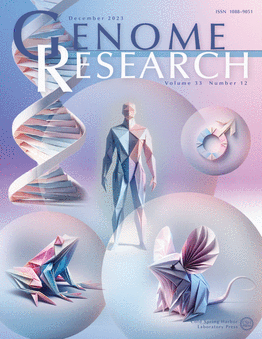Common cis-regulatory variation modifies the penetrance of pathogenic SHROOM3 variants in craniofacial microsomia
IF 6.2
2区 生物学
Q1 BIOCHEMISTRY & MOLECULAR BIOLOGY
引用次数: 0
Abstract
Pathogenic coding variants have been identified in thousands of genes, yet the mechanisms underlying the incomplete penetrance in individuals carrying these variants are poorly understood. In this study, in a cohort of 2009 craniofacial microsomia (CFM) patients of Chinese ancestry and 2625 Han Chinese controls, we identified multiple predicted pathogenic coding variants in SHROOM3 in both CFM patients and healthy individuals. We found that the penetrance of CFM correlates with specific haplotype combinations containing likely pathogenic-coding SHROOM3 variants and CFM-associated expression quantitative trait loci (eQTLs) of SHROOM3 expression. Further investigations implicate specific eQTL combinations, such as rs1001322 or rs344131, in combination with other significant CFM-associated eQTLs, which we term combined eQTL phenotype modifiers (CePMods). We additionally show that rs344131, located within a regulatory enhancer region of SHROOM3, demonstrates allele-specific effects on enhancer activity and thus impacts expression levels of the associated SHROOM3 allele harboring any rare coding variant. Our findings also suggest that CePMods may serve as pathogenic determinants, even in the absence of rare deleterious coding variants in SHROOM3. This highlights the critical role of allelic expression in determining the penetrance and severity of craniofacial abnormalities, including microtia and facial asymmetry. Additionally, using quantitative phenotyping, we demonstrate that both microtia and facial asymmetry are present in two separate Shroom3 mouse models, the severity of which is dependent on gene dosage. Our study establishes SHROOM3 as a likely pathogenic gene for CFM and demonstrates eQTLs as determinants of modified penetrance in the manifestation of the disease in individuals carrying likely pathogenic rare coding variants.目前已在数千个基因中发现了致病性编码变异,但对携带这些变异的个体的不完全渗透性的机制却知之甚少。在这项研究中,我们在 2009 名中国血统的颅面小畸形(CFM)患者和 2625 名汉族对照人群中发现了 SHROOM3 中的多个预测致病编码变异。我们发现,CFM 的渗透性与包含可能致病的 SHROOM3 编码变异的特定单倍型组合和 CFM 相关的 SHROOM3 表达定量性状位点(eQTLs)相关。进一步的研究表明,rs1001322 或 rs344131 等特定 eQTL 组合与其他重要的 CFM 相关 eQTL(我们称之为联合 eQTL 表型修饰因子(CePMods))结合在一起。我们还发现,位于 SHROOM3 调控增强子区域的 rs344131 对增强子活性有等位基因特异性影响,从而影响携带任何罕见编码变异的相关 SHROOM3 等位基因的表达水平。我们的研究结果还表明,即使 SHROOM3 中不存在罕见的有害编码变异,CePMods 也可能是致病的决定因素。这凸显了等位基因表达在决定包括小耳症和面部不对称在内的颅面异常的渗透性和严重程度方面的关键作用。此外,通过定量表型分析,我们证明在两个不同的 Shroom3 小鼠模型中都存在小耳症和面部不对称,其严重程度取决于基因剂量。我们的研究确定了 SHROOM3 可能是 CFM 的致病基因,并证明了 eQTL 是携带可能致病的罕见编码变异的个体在疾病表现中改变渗透性的决定因素。
本文章由计算机程序翻译,如有差异,请以英文原文为准。
求助全文
约1分钟内获得全文
求助全文
来源期刊

Genome research
生物-生化与分子生物学
CiteScore
12.40
自引率
1.40%
发文量
140
审稿时长
6 months
期刊介绍:
Launched in 1995, Genome Research is an international, continuously published, peer-reviewed journal that focuses on research that provides novel insights into the genome biology of all organisms, including advances in genomic medicine.
Among the topics considered by the journal are genome structure and function, comparative genomics, molecular evolution, genome-scale quantitative and population genetics, proteomics, epigenomics, and systems biology. The journal also features exciting gene discoveries and reports of cutting-edge computational biology and high-throughput methodologies.
New data in these areas are published as research papers, or methods and resource reports that provide novel information on technologies or tools that will be of interest to a broad readership. Complete data sets are presented electronically on the journal''s web site where appropriate. The journal also provides Reviews, Perspectives, and Insight/Outlook articles, which present commentary on the latest advances published both here and elsewhere, placing such progress in its broader biological context.
 求助内容:
求助内容: 应助结果提醒方式:
应助结果提醒方式:


